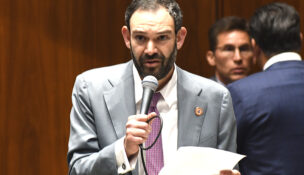National Park employees spend more time aiding Border Patrol
Arizona Capitol Reports Staff//June 23, 2006//[read_meter]
National Park employees spend more time aiding Border Patrol
Arizona Capitol Reports Staff//June 23, 2006//[read_meter]
Four years after drug smugglers fleeing Mexican police fatally shot park ranger Kris Eggle, an $18 million, 30-mile steel-and-concrete vehicle barrier has almost stopped such incursions at this desert park of Organ Pipe Cactus National Monument on the Arizona-Mexico border.
But many other problems remain.
The national crackdown on the southern border after the Sept. 11, 2001, terrorist attacks has forced drug and human traffickers to find more rural entryways into Arizona.
Thousands of people cross through the park on foot, leaving piles of trash, building fires, damaging the park’s famous cacti and creating countless new trails through the fragile desert.
Copyright 2006 Associated Press. All rights reserved. This material may not be published, broadcast, rewritten or redistributed.
Park staffers spend most of their time backing up Border Patrol officers and dealing with border issues. They are some of the countless new responsibilities national park officials across the country have taken on since Sept. 11.
“This tears my heart out, seeing the impacts on this place,” Organ Pipe Superintendent Kathy Billings says, surveying a fresh track through the coarse sand.
The problems aren’t just on the border. New security measures have been added at national icons, such as the Washington Monument, Independence Hall and Mount Rushmore.
Since 2001, the Park Service has received an additional $35 million in recurring funding. The government also provided $91 million in one-time dollars for icon parks and $18 million for the vehicle barrier at Organ Pipe.
But park superintendents and advocates say the costs are much higher.
As Americans gear up for summer visits to national parks, advocates say the parks are struggling to shoulder all of the expenses, compromising safety and visitors’ enjoyment.
For example, Organ Pipe spends about $100,000 a year from its maintenance budget to repair the vehicle barrier and a road next to it, which is used almost exclusively by the Border Patrol.
“We’d like to see the Park Service reimbursed,” said Blake Selzer of the National Parks Conservation Association, an advocacy group. “To truly address this issue, the amount of money is going to have to go up.”
After Sept. 11
After the Sept. 11 attacks, the Interior Department suddenly realized its law enforcement and homeland security capabilities quickly needed strengthening in parks and other public lands, particularly along borders, said Deputy Interior Secretary Lynn Scarlett.
It was “a newly identified priority,” she said in an interview. Interior officials acknowledged among themselves that, “Gee, this is a new or another area where we really need to give a shot in the arm of additional investment,” she said.
Shortly after the attacks, park rangers and other federal land and wildlife officers were regularly pulled away from their duties to guard national monuments, government buildings and even dams.
Those extra assignments have, for the most part, ended.
But park officials have absorbed other duties, including interdicting drugs in California’s Sequoia National Park, and aiding law enforcement at Texas’ Amistad National Recreation Area and Arizona’s Coronado National Memorial.
The problems may be most acute at the Organ Pipe Cactus National Monument.
Organ Pipe rangers arrest 385 smugglers in 2 years
The park, which gets its name from a rare, multipronged cactus resembling the vertical pipes of an organ, consists of rolling desert and boulder-encrusted hills. In places, rugged rock outcroppings separate the U.S. and Mexico. There, the new vehicle barrier is built in double-crosses like those erected on the Normandy coast during World War II.
While Ms. Billings shows visitors the newly erected fence, the park is eerily quiet. She squints into the brown, rocky hills.
“Right now we’re being watched by someone,” she says, meaning either Border Patrol or a smuggler’s scout. “That’s life on the border.”
In the last two years, Organ Pipe park rangers arrested 385 felony smugglers, seized 40,000 pounds of marijuana and caught 3,800 migrants.
Several trails are closed to visitors and staff indefinitely because they cross smugglers’ paths. But visitors still come into contact with illegal immigrants. Once, hikers discovered 10 backpacks of marijuana, each containing 50 or 60 pounds of drugs.
A trained biologist, Ms. Billings says she never thought she’d find herself in the business of fence repair and border protection.
But then, she adds, “We never thought national parks would be conduits for terrorists into the United States. I don’t think any of us knew the meaning of that word.”
Duties increase faster than funds
Ms. Scarlett said it would be wrong to characterize the extra duties as a drain on Interior resources.
“That’s a misframing of the question,” she said. “It’s not either-or. It’s not a matter of, do we invest in our parks or do we invest in homeland security? It’s how do we invest in our parks holistically?’’
But many park officials say their duties have increased faster than the money.
In Texas’ Big Bend National Park, which follows the curve of the Rio Grande for 118 miles, the number of illegal immigrants caught each year has tripled to about 1,200 since 2001, while the number of park rangers has stayed the same.
After Sept. 11, officials closed border crossings from Big Bend into Mexico, where park visitors once patronized little towns to buy trinkets. Since the tourist traffic dried up, villagers on the Mexican side have been forced to find new ways to make a living, said Chief Ranger Mark Spier, who is sure they slip into the park to harvest candelilla plants, which produce a high-quality wax, and to hunt deer.
Drug smugglers in California have decided it’s easier to grow marijuana in Sequoia National Park, and other remote public lands than smuggle it into the U.S.
The Park Service has removed more than 113,000 marijuana plants from Sequoia since 2001. This spring, park staffers finished a month-long project to restore 166 acres of wilderness damaged by farming. Crews removed 4,650 pounds of garbage and equipment — including 5.3 miles of irrigation hose and more than 5,000 pounds of fertilizer — from 31 gardens and seven camps.
Sequoia has received some money to help with law enforcement and forest restoration. But Chief Ranger J.D. Swed said $2 million “would provide a much safer place for people in general.”
Where Congress stands
U.S. Sen. Craig Thomas, R-Wyo., offered an amendment to the immigration bill in April that would turn over the responsibility for security in parks to Customs and Border Protection.
The fate of the measure is unclear. The House and Senate still must reach a compromise on the contentious bill this summer.
Mr. Thomas’ amendment also provides unmanned aerial vehicles, remote video surveillance cameras and sensors along the border.
“While I understand that the Park Service law enforcement will inevitably play a role in border security, we need to keep their jobs focused on protecting the park, not our international borders,” he said in a statement.
Ms. Billings says cameras would be especially useful in Organ Pipe, where smugglers already have tried to breach the vehicle barrier.
She says the damage to the Sonoran Desert has been hard to watch.
“I’m supposed to protect this place,” she says. “The scars will be here for years and years and years.”
Associated Press Writer John Heilprin contributed from Washington.

















